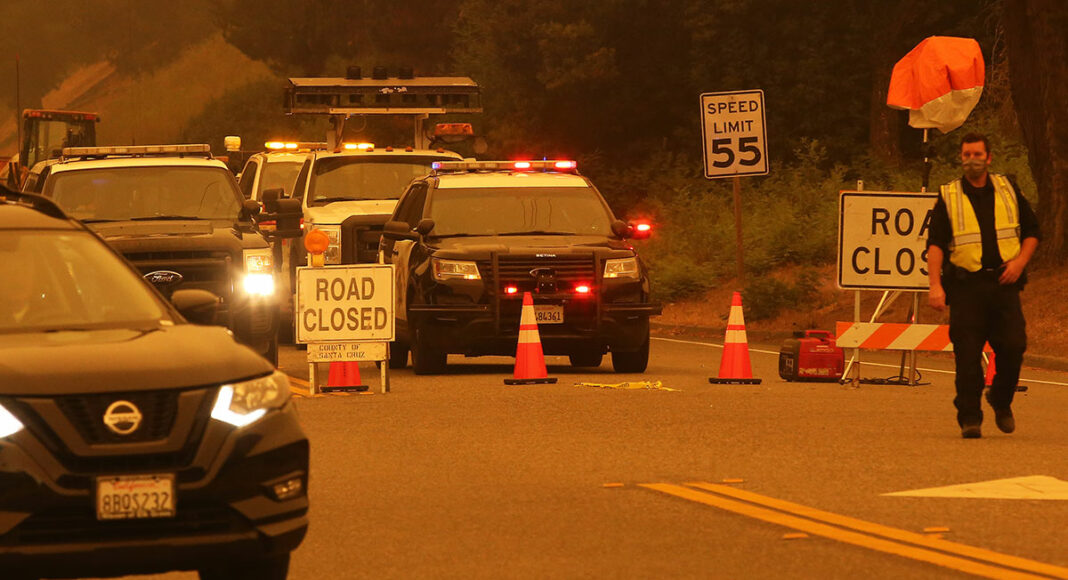California is making history.
Wildfires have now burned two million acres this year, a Cal Fire spokesperson told the Associated Press on Monday, making 2020 the worst fire year on record since the state first started keeping track in 1987.
The fires include the CZU Lightning Complex, which ripped through the Santa Cruz Mountains, destroying more than 900 homes to become the ninth-most destructive fire in state history. Meanwhile, the second- and third-largest fires in state history—the LNU Lightning Complex and the SCU Lightning Complex—have been burning in the San Francisco Bay Area. A dry lightning storm ignited those fires. More fires started over the past weekend, including ones in Fresno and San Bernardino counties.
And the fall, which often presents some of the most challenging firefighting conditions, hasn’t even yet begun.
Fighting Crew
The unprecedented scale of multiple fires burning simultaneously has stretched California’s resources thin.
In 2008, authorities summoned 67 fire engines, 29 hand crews, 11 water tenders, eight air tankers and five helicopters to fight a 520-acre blaze that razed three homes in Bonny Doon. By comparison, as the CZU Complex burning through the same terrain reached 78,000 acres in the week of Aug. 24, Cal Fire had at its disposal just 167 engines, 18 dozers, 37 water tenders, nine helicopters and 23 crews.
The fires have laid bare the state’s heavy reliance on prison labor. To prevent Covid-19 outbreaks behind bars, the California Department of Corrections this summer released thousands of inmates, including those assigned to fight fires.
“We definitely are stretched thin—more so than I’ve ever seen,” says Cal Fire spokesman Joe Amador, a San Diego fire captain assigned to work the media hotline for the SCU Complex.
Cal Fire had 2,800 inmate firefighters to activate in 2019 compared to just 1,300 this year. Inmates deployed to California’s fiery frontlines make $1 an hour to do some of the toughest work, staffing “hand crews” that use shovels and chainsaws to cut firelines in places inaccessible to bulldozers, or if machines aren’t available.
There were still some such crews on the front lines locally. At the peak of the CZU blaze, Cal Fire’s San Mateo-Santa Cruz unit had 362 inmate personnel fighting the fire, spokesperson Cecile Juliette says.
Fire Brigade
One former inmate, Matthew Hahn, 40, stepped outside his San Jose home on Aug. 19 to see ash falling from an orange, hazy sky, and decided to pack a camera before heading to work. “I’m a hobbyist photographer,” he says, “and I figured I’d get some good shots on a day.”
Scouting for good angles brought him to the edge of the CZU as the fires marched north through San Mateo County. While snapping photos by Pescadero Creek, Hahn says the sound of a chainsaw stirred “a visceral memory” of his years as an inmate firefighter.
“I heard a hand crew, a saw team,” he says, “and I felt a little bit of an itch.”
The next day at work, he says a friend called with terrible news that moved him to action. “She told me her house burned down in Bonny Doon,” Hahn says. “She was beside herself, saying, ‘If only we had gotten there an hour earlier, it could have been saved’—because it wasn’t like a fast flame, it sort of creeped up on her house.”
Figuring his hand crew experience could save other homes from the same fate, Hahn put out a call on Twitter for other ex-inmate firefighters. After leaving work early, he stopped by Home Depot to buy a chainsaw, shovels, axes, oil, rakes, gloves, goggles and other tools for anyone who showed up to help.
Then he headed to Bonny Doon, expecting to lend a hand by clearing brush or dousing stray embers. Instead, he stumbled upon a cohort of impressively prepared volunteers playing more than just defense. With Cal Fire pulled to other fronts, scores of residents equipped with water trucks, fire hoses and bulldozers stayed to protect their tiny town.
“When I got there, I realized that this is a different beast altogether,” he says. “They knew what they were doing. They were ready to not only defend their homes, but to fight spot fires. They basically created their own community fire brigade.”
Cal Fire has repeatedly given public scoldings to informal firefighting groups—including ones in Bonny Doon—who stayed behind to protect their homes, arguing that they could get in the way and need rescuing. But over the course of two days, Hahn helped the guerrilla firefighters extinguish blazes, secure structures and cut lines to protect the town. Their efforts saved a lavender farm from a fire that came roaring up a hill with what he says must’ve been 45-foot flames.
“The fire breaks we created managed to stop it,” Hahn recounts.
With wildfire seasons coming sooner and more intensely every year, and Cal Fire overwhelmed as it is, Hahn thinks the state would do well to support volunteer crews as organized as the ones he encountered in Bonny Doon.
What’s more, he says, California could hire from the sizable pool of ex-inmate firefighters who trained on the taxpayer’s dime for exactly the work Cal Fire needs help with right now.
Sure enough, since Hahn helped out the Bonny Doon brigade, the state legislature has passed a bill that would allow California to hire former inmates as firefighters. It’s on Gov. Gavin Newsom’s desk, awaiting approval.
“You have probably thousands of these trained personnel throughout the state who can’t get hired because of their criminal record,” Hahn says. “The world isn’t getting cooler, and California isn’t getting wetter. Why don’t we tap this resource when disaster hits?”













